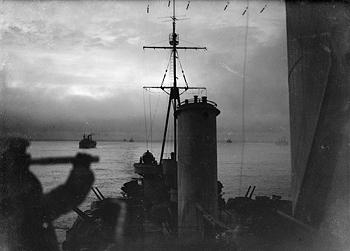|
Gefallen Engel U-666
Join Date: Jul 2013
Location: On a tilted, overheated, overpopulated spinning mudball on Collision course with Andromeda Galaxy
Posts: 30,064
Downloads: 24
Uploads: 0
|

Quote:
|
Originally Posted by K-61
There is nothing that screams out to me, "ahistorical!" than seeing a capital ship or ships escorting a convoy actually being in the convoy, and forced to proceed at the convoy's pace.
|
Well to every rule there is an occasional exception! I consider a cruiser a capital ship...and there is the HMS Sheffield Southampton sub class of the Town-classcruisers (with stainless steel fittings) clearly in the Artic/Murmansk bound convoy. HMS Sheffield engaged and sank German destroyer Friedrich Eckoldt, while also damaging the cruiser Admiral Hipper in the Battle of the Barent's Sea. Pic or it didn't happen: HMS Sheffield at starboard- front on convoy I consider a cruiser a capital ship...and there is the HMS Sheffield Southampton sub class of the Town-classcruisers (with stainless steel fittings) clearly in the Artic/Murmansk bound convoy. HMS Sheffield engaged and sank German destroyer Friedrich Eckoldt, while also damaging the cruiser Admiral Hipper in the Battle of the Barent's Sea. Pic or it didn't happen: HMS Sheffield at starboard- front on convoy  good reading here: https://en.wikipedia.org/wiki/Arctic_convoys_of_World_War_II On yet another occasion : The deterrence value of a battleship in protecting a convoy was also dramatically illustrated when the German light battleships (referred by some as battlecruisers) Scharnhorst and Gneisenau, mounting 11 in (28 cm) guns, came upon an eastbound British convoy (HX-106, with 41 ships) in the North Atlantic on February 8, 1941. When the Germans detected the slow but well-protected battleship HMS Ramillies escorting the convoy, (clearly at convoy speed) they fled the scene rather than risk damage from her 15 in (38 cm) guns. On yet another convoy operation: good reading here: https://en.wikipedia.org/wiki/Arctic_convoys_of_World_War_II On yet another occasion : The deterrence value of a battleship in protecting a convoy was also dramatically illustrated when the German light battleships (referred by some as battlecruisers) Scharnhorst and Gneisenau, mounting 11 in (28 cm) guns, came upon an eastbound British convoy (HX-106, with 41 ships) in the North Atlantic on February 8, 1941. When the Germans detected the slow but well-protected battleship HMS Ramillies escorting the convoy, (clearly at convoy speed) they fled the scene rather than risk damage from her 15 in (38 cm) guns. On yet another convoy operation:
On 8 February 1941 Ramillies was on duty in the North Atlantic Ocean, escorting Convoy HX 106 comprising 41 ships eastbound from Halifax, Nova Scotia to Liverpool, England, when the two German battleships Scharnhorst and Gneisenau appeared over the horizon. The German squadron was under the command of Admiral Günther Lütjens. The captain of the Scharnhorst offered to draw off the Ramillies, so that the Gneisenau could sink the merchant ships. It is unlikely, however, that Ramillies ' captain would have left the convoy he was protecting to chase the much faster German ship. Further, Ramillies was armed with the excellent 15 inch gun and was capable of doing significant damage to the German vessels. In the event, Lütjens strictly followed Adolf Hitler's directive not to engage enemy capital ships. The presence of Ramillies was sufficient to deter the attack.
On 24 May 1941, Ramillies, with Captain Arthur D. Read commanding, was south of Cape Farewell, Greenland, on duty escorting Convoy HX 127 eastbound from Halifax. Some 57 merchant ships were in the group bound for Liverpool, with the most common cargoes being, oil, aviation spirit, lubricants, gasoline, lumber, grain, steel, sugar, scrap iron and pig iron. Two ships carried general cargo, and there were single ships carrying molasses, trucks and cereals. Other escort vessels were designed to meet the submarine menace, and included a modern Canadian destroyer, HMCS Ottawa, the Indian navy sloop, HMIS Sutlej, an obsolete ex-US Navy destroyer, HMS Salisbury, an escort destroyer, HMS Hambledon, the corvettes HMS Larkspur, HMS Begonia and several other smaller ships. If anything, Ramillies would have been a liability dealing with submarines. She was there as insurance against attack by surface raiders.
If Ramillies had to face a major surface attack, the two destroyers were probably the only escorts of value to her.
The new German battleship Bismarck broke out into the North Atlantic after sinking the battlecruiser HMS Hood, Britain's largest warship, in the Battle of the Denmark Strait. Ramillies was well east of Newfoundland to the southwest of Bismarck, and if she had continued her raid, Ramillies was all that the Royal Navy had to stop her from ravaging the sealanes off North America. On 24 May 1941 the Admiralty ordered Ramillies to leave the convoy and steam on a course to intercept the enemy ship. Bismarck had sustained some damage in the action against the Prince of Wales, and opted to make for France for repairs, instead of continuing on a convoy raiding mission.
It was a measure of the desperation of the Royal Navy that such an old ship was sent out alone to intercept one of the world's most potent battleships which was supported by the heavy cruiser Prinz Eugen. [wiki] Fortunately for her, she was not put to the test. In fact the capital ships on convoy duty were expendable; a hard fact of war....  HMS Ramillies' excellent 15" gun at British Imperial War Museum HMS Ramillies' excellent 15" gun at British Imperial War Museum
|